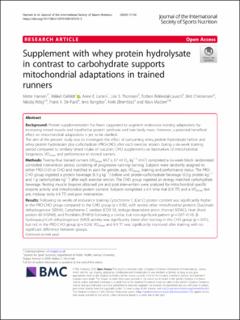| dc.contributor.author | Hansen, Mette | |
| dc.contributor.author | Oxfeldt, Mikkel | |
| dc.contributor.author | Larsen, Anne E. | |
| dc.contributor.author | Thomsen, Lise S. | |
| dc.contributor.author | Rokkedal-Lausch, Torben | |
| dc.contributor.author | Christensen, Britt | |
| dc.contributor.author | Rittig, Nikolaj | |
| dc.contributor.author | De Paoli, Frank V. | |
| dc.contributor.author | Bangsbo, Jens | |
| dc.contributor.author | Ørtenblad, Niels | |
| dc.contributor.author | Madsen, Klavs | |
| dc.date.accessioned | 2021-02-01T10:44:08Z | |
| dc.date.available | 2021-02-01T10:44:08Z | |
| dc.date.created | 2020-11-01T10:26:14Z | |
| dc.date.issued | 2020 | |
| dc.identifier.citation | Journal of the International Society of Sports Nutrition. 2020, 17(2020), Artikkel 46. | en_US |
| dc.identifier.issn | 1550-2783 | |
| dc.identifier.uri | https://hdl.handle.net/11250/2725532 | |
| dc.description | This article is licensed under a Creative Commons Attribution 4.0 International License, which permits use, sharing, adaptation, distribution and reproduction in any medium or format, as long as you give appropriate credit to the original author(s) and the source, provide a link to the Creative Commons licence, and indicate if changes were made. The images or other third party material in this article are included in the article's Creative Commons licence, unless indicated otherwise in a credit line to the material. If material is not included in the article's Creative Commons licence and your intended use is not permitted by statutory regulation or exceeds the permitted use, you will need to obtain permission directly from the copyright holder. To view a copy of this licence, visit http://creativecommons.org/licenses/by/4.0/. The Creative Commons Public Domain Dedication waiver (http://creativecommons.org/publicdomain/zero/1.0/) applies to the data made available in this article, unless otherwise stated in a credit line to the data. | en_US |
| dc.description.abstract | Background: Protein supplementation has been suggested to augment endurance training adaptations by increasing mixed muscle and myofibrillar protein synthesis and lean body mass. However, a potential beneficial effect on mitochondrial adaptations is yet to be clarified. The aim of the present study was to investigate the effect of consuming whey protein hydrolysate before and whey protein hydrolysate plus carbohydrate (PRO-CHO) after each exercise session during a six-week training period compared to similarly timed intake of isocaloric CHO supplements on biomarkers of mitochondrial biogenesis, VO2max and performance in trained runners. Methods: Twenty-four trained runners (VO2max 60.7 ± 3.7 ml O2 kg− 1 min1) completed a six-week block randomized controlled intervention period, consisting of progressive running training. Subjects were randomly assigned to either PRO-CHO or CHO and matched in pairs for gender, age, VO2max, training and performance status. The PRO-CHO group ingested a protein beverage (0.3 g kg− 1) before and protein-carbohydrate beverage (0.3 g protein kg− 1 and 1 g carbohydrate kg− 1) after each exercise session. The CHO group ingested an energy matched carbohydrate beverage. Resting muscle biopsies obtained pre and post intervention were analyzed for mitochondrial specific enzyme activity and mitochondrial protein content. Subjects completed a 6 K time trial (6 K TT) and a VO2max test pre, midway (only 6 K TT) and post intervention. Results: Following six weeks of endurance training Cytochrome C (Cyt C) protein content was significantly higher in the PRO-CHO group compared to the CHO group (p < 0.05), with several other mitochondrial proteins (Succinate dehydrogenase (SDHA), Cytochrome C oxidase (COX-IV), Voltage-dependent anion channel (VDAC), Heat shock protein 60 (HSP60), and Prohibitin (PHB1)) following a similar, but non-significant pattern (p = 0.07–0.14). β-hydroxyacyl-CoA dehydrogenase (HAD) activity was significantly lower after training in the CHO group (p < 0.01), but not in the PRO-CHO group (p = 0.24). VO2max and 6 K TT was significantly improved after training with no significant difference between groups. Conclusion: Intake of whey PRO hydrolysate before and whey PRO hydrolysate plus CHO after each exercise session during a six-week endurance training period may augment training effects on specific mitochondrial proteins compared to intake of iso-caloric CHO but does not alter VO2max or 6 K TT performance. | en_US |
| dc.language.iso | eng | en_US |
| dc.subject | sports nutrition | en_US |
| dc.subject | protein hydrolysate | en_US |
| dc.subject | performance | en_US |
| dc.subject | enzyme activity | en_US |
| dc.subject | skeletal muscle | en_US |
| dc.subject | mitochondria | en_US |
| dc.subject | endurance sport | en_US |
| dc.title | Supplement with whey protein hydrolysate in contrast to carbohydrate supports mitochondrial adaptations in trained runners | en_US |
| dc.type | Peer reviewed | en_US |
| dc.type | Journal article | en_US |
| dc.description.version | publishedVersion | en_US |
| dc.rights.holder | © The Author(s). 2020 | en_US |
| dc.source.pagenumber | 13 | en_US |
| dc.source.volume | 17 | en_US |
| dc.source.journal | Journal of the International Society of Sports Nutrition | en_US |
| dc.identifier.doi | 10.1186/s12970-020-00376-3 | |
| dc.identifier.cristin | 1843850 | |
| dc.description.localcode | Institutt for fysisk prestasjonsevne / Department of Physical Performance | en_US |
| cristin.ispublished | true | |
| cristin.fulltext | original | |
| cristin.qualitycode | 1 | |
